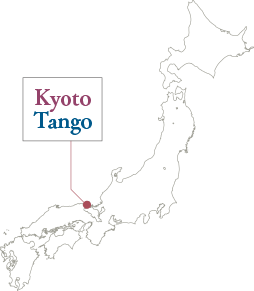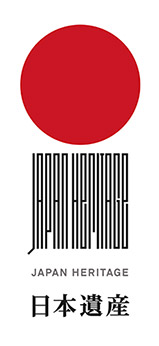About Tango Chirimen
Chirimen silk crepe is made in the Tango region of Kyoto Prefecture. About 130 km north of Kyoto City, Tango is far from the hustle and bustle of the city. What you see is a lot of nature and traditional townscapes that take you back in time. Surrounded by the Sea of Japan and mountains with sightseeing spots like Amanohashidate and Ine, Tango is where Tango chirimen is produced.
What is Tango chirimen?
The crimped surface gives it excellent depth and feel.
Blessed with the ocean, mountains, and nature, the Tango region has a seasonal wind called “uranishi” that blows from autumn to winter. This wind brings good water and suitable moisture to the land. This climate is ideal for silk weaving because silk threads do not like dry conditions. Silk weavers have been taking advantage of Tango’s climate since ancient times to make silk fabrics.
Tango chirimen’s main feature is its fine, crimped surface. Chirimen (meaning “shrunken surface”) is silk woven with alternating warp and weft threads on a plain fabric. The weft threads are highly twisted by the Hatcho-nenshi thread twister. After the fabric is made and refined, the crimped texture is created by the weft threads trying to untwist. This bumpy surface gives the silk fabric a special luster, depth, and unique suppleness. The crimped surface of white Tango chirimen makes it easy to dye immediately after being woven which really brings the colors to life. The bumpy texture also makes the fabric harder to wrinkle. Therefore, it is very well suited for kimono.




Tango produces 60 percent of Japan’s kimono fabrics.
Known for its elegance and outstanding functionality, Tango chirimen comes in a wide variety. Different warp and weft combinations create a myriad of fabrics. Even the main mon-chirimen fabric comes in over 1,000 standard designs.
The Tango region is currently Japan’s largest silk fabric production region. It produces about 60 percent of Japan’s kimono materials and accounts for over 30 percent of Japan’s silk consumption. Also, to suit the current times, new chirimen products are being developed with not just silk, but also with polyester, rayon, and other composite materials. These new products are being used in both Japanese and Western clothing and textiles.

Chirimen-Kaido and Former Bito Family Home
Yosano is one of the manufacturing centers of Tango chirimen. Chirimen-Kaido was used to transport silk products from the Tango region to the city of Kyoto. This area still has textile factories that have been operating since the Meiji Period and merchant homes, banks, and medical clinics from the Showa Period. As it was the distribution and information center of its time, linking Tango and Kyoto city, remnants of Chirimen-Kaido are still evident. The former Bito family merchant’s home is especially symbolic of Chirimen-Kaido.
The main home was built in 1865. It was later expanded and took its present form in 1941. Family head Shozo Bito was the president of the Kaya Railway, which he established to transport Tango chirimen to Kyoto and Osaka. He was also the Kaya Town Mayor and worked to promote local industries.
He also built a Western-style addition to the house. The first floor is Japanese-style, while the second floor is Western-style. The inner parlor and courtyard were unexpected surprises hidden from the front of the house.
○In 2006, Chirimen-Kaido was designated as an Important Preservation District for Groups of Traditional Buildings.
○In 2002, the Former Bito Family Home was designated as a Kyoto Prefecture Tangible Cultural Property.
○In 2017, Chirimen-Kaido and Former Bito Family Home were designated as a Japan Heritage for “300 Years of Silk on the Tango Chirimen-Kaido.”



About “Judenken”
“Judenken” is Important Preservation District for Groups of Traditional Buildings.
Based on Japan’s Law for the Protection of Cultural Properties and the recommendation of the local municipality, a group of traditional buildings in a castle town, post town, shrine district, temple district, port town, farming village, fishing village, etc., can be designated as an Important Preservation District by the Minister of Education, Culture, Sports, Science and Technology to preserve its historical environment.
If the buildings are especially valuable, “Important” is also prefixed. As of August 2018, Japan has 118 such districts in 98 municipalities in 43 prefectures.

About Japan Heritage
Japan’s Agency of Cultural Affairs designates regions in Japan that have historical appeal and special qualities that convey a traditional or cultural narrative of Japan. The narrative must pertain to the local history or have a fresh and interesting character to promote Japan and be able to revitalize the locale. Local policies must be in place for this.

 Former Bito Family Home special website(Japanese)
Former Bito Family Home special website(Japanese)